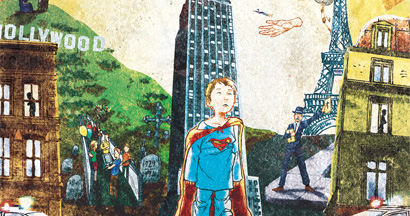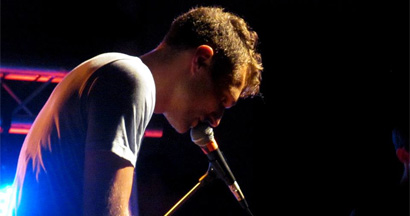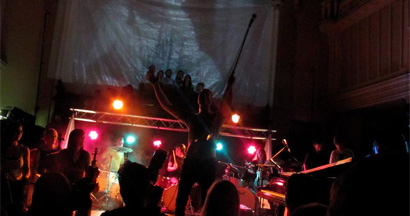Memory, Intertextuality and Rich Aucoin's We're All Dying to Live

If ‘album of the year’ acclaims were awarded literally—to the album which most sounds like the here and now—Halifax’s Rich Aucoin would be hogging all the hardware for 2011.
Indeed, unlike much of what gets tagged with the ‘indie rock’ genre these days, We’re All Dying to Live, Aucoin’s thrilling new full-length, really couldn’t have been made in any other era. It could be that its openness to dance and electronica reflects the current sensibilities of the pop and alternative realms, or that the album’s songs form the core of Aucoin’s bombastic, confetti-and-streamers live show that always feels effervescently now.
But interestingly, in many ways, We’re All Dying to Live actually looks back rather than forward. It sort of feels like an amalgam of the past decade, a summary statement of the countless musical forms that found themselves thrown under the parachute of ‘indie rock’ in the 2000s: collective singalong anthems, dance-floor ready electro, twinkling piano-driven interludes and slow-building balladry.
Put another way: it sounds kind of like your hard drive. Sometimes, rather candidly so.

What feels so current about the album isn’t that Aucoin borrows from other artists—-that’s a tale as old as time—but that he’s so transparent about it. Sometimes it’s just a sound homage that seems a bit on the nose, such as how you can hear echoes of The Flaming Lips on the album’s more ballad-y tracks like “All That You Cannot Live Without.” But then Aucoin offers up a song suite about waiting for Superman—also a motif from one of the Lips’ greatest songs—and your ears perk up. You might be reminded of Sufjan Stevens in the way We’re All Dying to Live’s various segments are named, but then you take a look at the record’s artwork and suddenly all you can think of is Illinois. Aucoin offers up a blatant Brian Wilson homage, and then titles the track “Brian Wilson is A.L.I.V.E.”
And then there’s “P.U.S.H.,” which adopts robot-speak with a meter, tone and sensibility that’s completely, 100 per cent Daft Punk’s “Harder Better Faster Stronger.” There’s no way you can hear that song and not think about Daft Punk. Not possible.
Traditionally, these are the sorts of liftings that you don’t get away with, at least with critical types. They’re rockist crimes, the things you do not do if you’re attempting to be taken seriously as an artist. With our understanding of creativity traditionally linked with originality, the worst thing you could do is show your influences so nakedly; at least have the decency to cover them up a little.
But hold up. We’re leaving a decade where arguably the defining emerging ‘genre,’ if one could call it that, was the mashup; where the MP3 meant that we collected, and shuffled through, more music than ever before; where nostalgia collided with the rediscovered past, and the Internet gave us access to smash anything and everything we wanted together. If we once understood the past as something that slowly faded away, today it feels like something so heavily present that it’s impossible to escape from – and perhaps our best recourse is to recontexualize it, to make it our own.

So Aucoin’s eclectic, engaging assortment of influences on We’re All Dying to Liveplaces him right in the centre of all this. Indeed, the fleeting familiarities come so fast—and are so quickly replaced with the next sound or recollection—that it’s the massive sprawl of the whole that resonates the strongest. What I find interesting, though, is that Aucoin’s embrace of the intertextual zeitgeist extends well beyond the record itself.
Consider, for example, Aucoin’s taste for syncing his songs to visual works. His first EP, Personal Publication, was designed to be played alongside the cartoon version ofThe Grinch Who Stole Christmas. In his live shows, Aucoin will often start songs by showing YouTube clips—like Double Rainbow guy—before launching into the song itself. And he’s made a full 55-minute film entirely out of public domain films to play alongside We’re All Dying to Live. Then there are the live ‘gimmicks,’ like the call-and-response to help ‘teach’ the audience to sing along; it’s not unlike a grade school music class learning the song line-by-line. And let’s not forget the playground parachute that Aucoin has a tendency to break out and hold a dance party underneath.
Put together, it’s clear that Aucoin isn’t just drawing upon musical memory to connect with his audience: he’s courting our visual memory, our childhood recollections and other elements of our lived experience. His routine, from the music through the aesthetic accompaniment (hello, Indiana Jones font), isn’t trying to create new meanings: it’s reminding us of meanings that already exist within ourselves, creating a patchwork (a rainbow parachute?) that feels familiar from the very first note. No wonder it’s so powerful: it’s as much our experience as his.
All this begs the question: why do we let Aucoin get away with this? Shouldn’t we be treating this sort of manipulation cynically?

We might, if Aucoin was the least bit cynical. But his masterstroke is that this intertextuality is inseparable from the other ‘inter-’ word that dominates We’re All Dying to Live: interdependency. Aucoin goes through great pains to make sure we know that more than 500 different musicians performed on the album. Though Aucoin’s voice is always present, it’s most often accompanied by harmonies or sometimes boisterous choruses by others. And in his live show, Aucoin seems more focused on getting the audience to sing along than on actually delivering the lines himself.
This emphasis on ‘we’ instead of ‘I’ extends to the album’s lyrical themes. Hell, ‘I’ is almost entirely absent: it’s pretty much just a chorus of ‘we’ or ‘us’ throughout the albums 22 segments. Those moments that do focus on individuals are either in the second person—the ‘you’ of “It,” for example—or the third person, like the ‘he’ and ‘she’ of tracks like “Undead” and “Living to Die.” The latter is indicative of Aucoin’s approach to pronouns: the song’s character, addressing his own mortality, moves beyond the individualist perspective to come to two collectivist conclusions: “we’re in this together” and “we’re all dying to live.”
And just as Aucoin generously acknowledges his musical touchpoints by making them so obvious, he’s equally as giving to his guest performers. This was abundantly clear during the Halifax Pop Explosion, when Aucoin delivered the show of the festival—hell, maybe Halifax’s show of the year—by performing We’re All Dying to Live start-to-finish at St. Matthew’s Church, with upwards of 70 or 80 different musicians supporting him. There were four drum kits, a string section, a horn section, and dozens of background vocalists. Aucoin even gave up a good 25 minutes at the start of the show to let some of his friends each play one of their own songs. This was a big shared experience, and though there was one man conducting it from the centre, every effort was made to demonstrate that none of this was possible without the support of a broader community of friends and colleagues.
And it’s in that sense of collectiveness—where the music’s intertextuality meets its interdependency—that Aucoin’s raison d’être reveals itself: coming to terms with, and celebrating, how everyone (and everything) leans on someone (and something) else to get by.
It’s an idea perhaps expressed best in “Undead’s” final line: “We’ll lie but we’ll never die alone.”
From McNutt Against the Music. Follow McNutt on Twitter.
Subscribe to Maisonneuve today.
Related on maisonneuve.org:
—Arcade Fire, Tune-Yards and Growing Up
—9/11, New York Music and Cultural Memory
—Halifax Pop Explosion 2011 in Pictures





